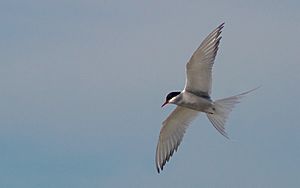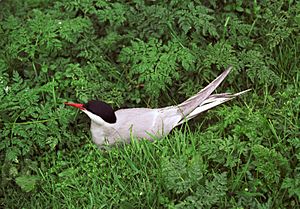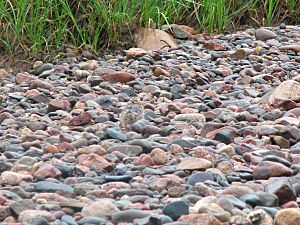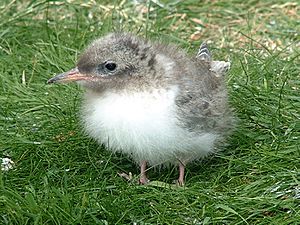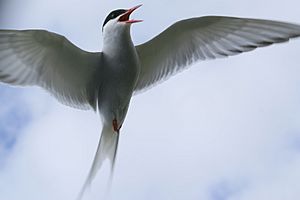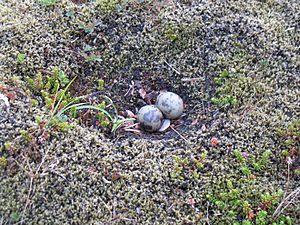Arctic tern facts for kids
Quick facts for kids Arctic tern |
|
|---|---|
 |
|
| Conservation status | |
| Scientific classification | |
| Kingdom: | |
| Phylum: | |
| Class: | |
| Order: | |
| Family: | |
| Genus: |
Sterna
|
| Binomial name | |
| Sterna paradisaea |
|
The Arctic tern (Sterna paradisaea) is a medium-sized seabird. It lives and raises its young in the Arctic and sub-Arctic areas. These regions include parts of Europe, Asia, and North America. This amazing bird is famous for having the longest migration of any known animal. Each year, it travels about 70,900 kilometers (44,100 miles)!
Arctic terns are so special that they appear on postage stamps. You can find them on stamps from places like the Åland Islands, Alderney, and Faroe Islands. They are also on stamps from Canada, Finland, Iceland, and Cuba.
Contents
What Does an Arctic Tern Look Like?
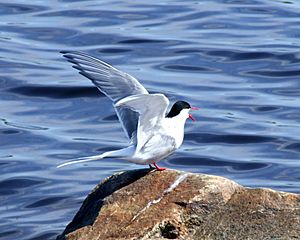
The Arctic Tern is a medium-sized bird. It measures about 33–36 centimeters (13–15 inches) from its beak to its tail. Its wings can spread out to 76–85 centimeters (30–33 inches). An adult bird usually weighs between 86–127 grams (3.0–4.5 ounces).
This bird has a dark red beak and short red legs. Its feet are webbed, which helps it swim. Like most terns, it has long, narrow wings. Its tail is deeply forked, like a V-shape.
Adult Arctic Terns have grey feathers on their backs and wings. Their head has a black cap, and their cheeks are white. The tips of their wings look a bit see-through. Their tail is white, and their belly is light grey. Both male and female terns look very similar. In winter, their black cap becomes whiter, and their beaks get darker.
Young Arctic Terns look a bit different. They have black beaks and legs. Their wings look "scaly," and their feathers have dark tips. They also have a dark bar on their wings and short tail streamers.
How Do Arctic Terns Communicate?
Arctic Terns make many different sounds. The two most common calls are the alarm call and the advertising call. They use the alarm call when predators, like humans or other mammals, come near their nests.
The advertising call is used when they return to their colony. They also use it when they have arguments with other terns. Each tern has a unique advertising call. This helps them recognize each other, much like a bird song helps passerines identify individuals. Scientists have described eight other calls. These range from begging calls by females during mating to attack calls when they dive at intruders.
Arctic Terns look a lot like Common and Roseate Terns. However, their colors, shape, and calls are slightly different. The Arctic Tern has a longer tail and a solid-colored beak compared to the Common Tern. It is also a bit darker and has longer wings than the Roseate Tern. The Arctic Tern's call sounds more "nasal" or "raspy" than the Common Tern's. It is also easy to tell apart from the Roseate Tern's call.
Arctic Tern Family Life
Arctic Terns usually start having chicks when they are three or four years old. They mate for life, meaning they stay with the same partner. Most pairs return to the same nesting spot every year.
Their courtship is quite fancy, especially for birds nesting for the first time. It starts with a "high flight." The female chases the male high into the sky, then they slowly fly back down. After this, they do "fish flights." The male brings fish to the female as a gift. On the ground, they strut around with their tails up and wings down. Then, both birds usually fly in circles around each other.
Both the male and female choose a spot for their nest. They both work to protect this spot. During this time, the male keeps feeding the female. Mating happens soon after.
Arctic Terns nest in large groups called colonies. These colonies are found on coasts, islands, or sometimes inland on tundra near water. They often nest alongside Common Terns. A female usually lays one to three eggs, but most often two.
These birds are very protective of their nests and young. They will bravely attack humans and large predators. They usually strike the top or back of the head. Even though they are small, they can sometimes make you bleed! Other birds sometimes nest near Arctic Terns because they benefit from this strong defense.
The nest is usually just a shallow dip in the ground. It might have some bits of grass or other materials. The eggs are speckled, which helps them blend in with the ground. Both parents take turns sitting on the eggs to keep them warm. The chicks hatch after 22–27 days. If the parents are disturbed often, it can take up to 34 days.
When they hatch, the chicks are covered in soft down. They can move around and explore their surroundings within one to three days. They usually stay close to the nest. The parents keep the chicks warm for the first ten days. Both parents feed the young. Chicks always eat fish, and parents bring them larger fish than they eat themselves. Male terns bring more food than females.
Parents feed their chicks for about a month. Then, the young birds slowly learn to feed themselves. This includes learning how to dive headfirst into the water to catch fish. After they can fly, the young terns will travel south for the winter with their parents.
Arctic Terns live a long time. The oldest recorded Arctic Tern lived for 34 years! On average, they live about 20 years. They spend a lot of time raising just a few young.
What Do Arctic Terns Eat?
The diet of the Arctic Tern changes depending on where they are and the time of year. But they are mostly meat-eaters. They usually eat small fish or marine crustaceans (like crabs or shrimp). Fish are the most important part of their diet. They often eat young (1–2 year old) schooling fish such as herring, cod, sandlances, and capelin. They also eat marine crustaceans like amphipods, crabs, and krill.
Sometimes, these birds also eat molluscs, marine worms, or berries. In their northern breeding areas, they might even eat insects.
Arctic Terns sometimes dip down to the water's surface to catch prey. They might also chase insects in the air when they are nesting. It is also thought that Arctic Terns might sometimes steal food from other birds. This is called kleptoparasitism. They swoop at other birds to scare them into dropping their catches. They target other terns, and even some auk and grebe species.
Predators and Defense
When nesting, Arctic Terns can be attacked by cats and other animals. The larger Herring Gull also competes for nesting spots. Herring Gulls will steal eggs and young chicks. The terns' camouflaged eggs help protect them. Nesting in isolated spots also helps.
While feeding, skuas, gulls, and other tern species will often bother Arctic Terns and try to steal their food. Arctic Terns often nest in mixed groups with other terns, like Common and Sandwich Terns.
Images for kids
-
Nesting with an egg in Schleswig-Holstein, Germany
See also
 In Spanish: Charrán ártico para niños
In Spanish: Charrán ártico para niños



